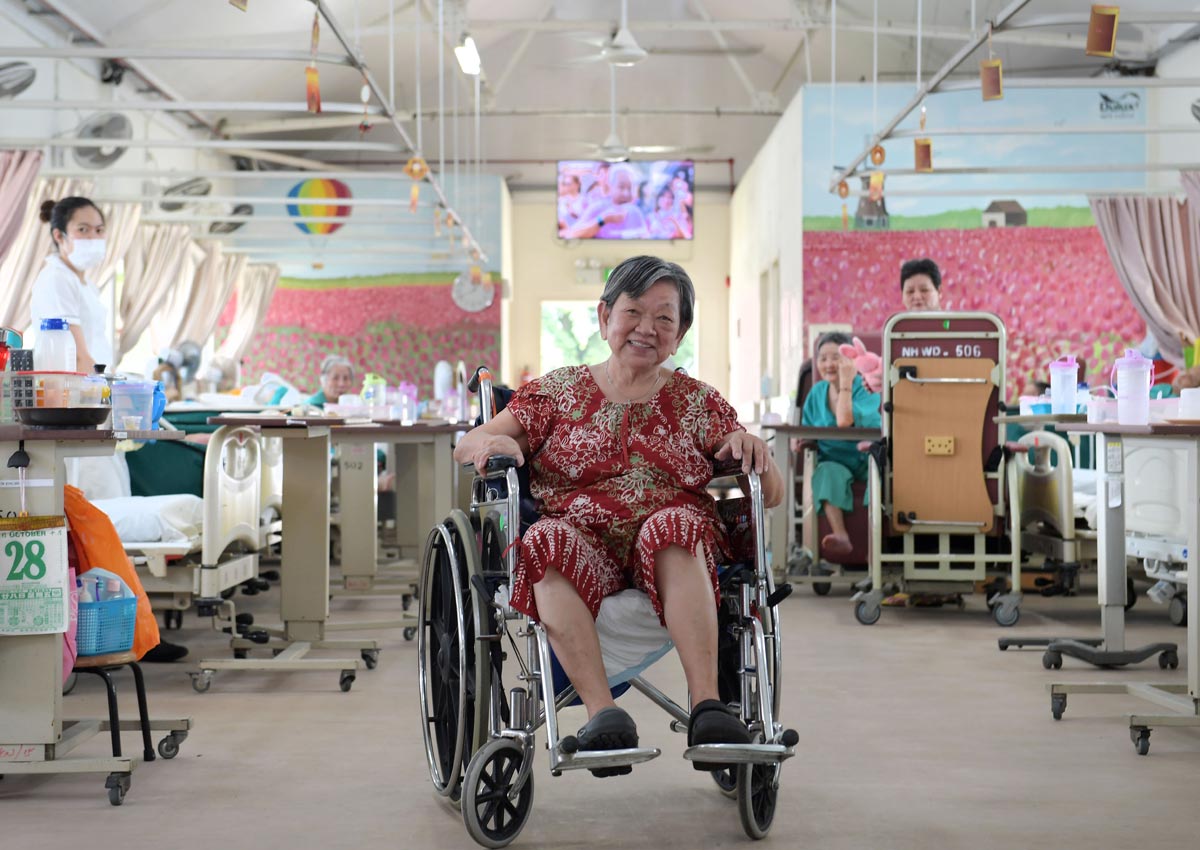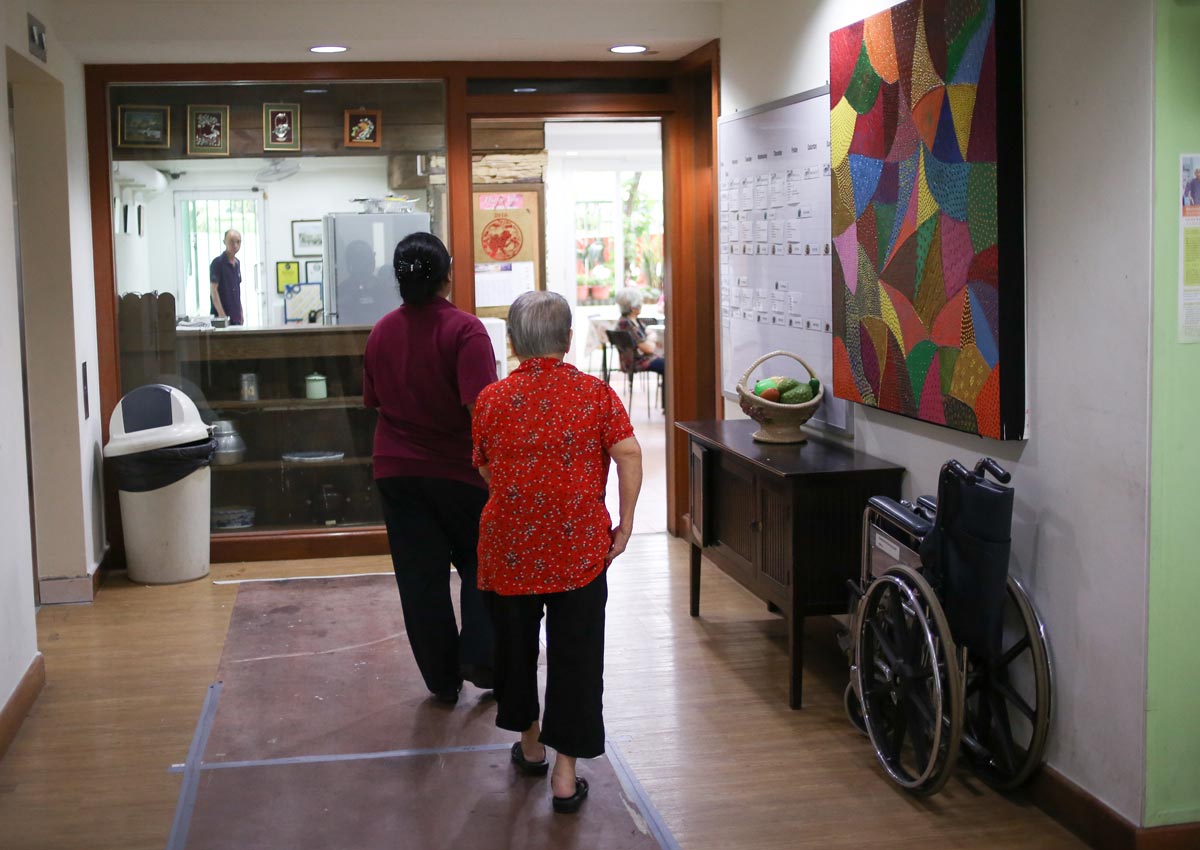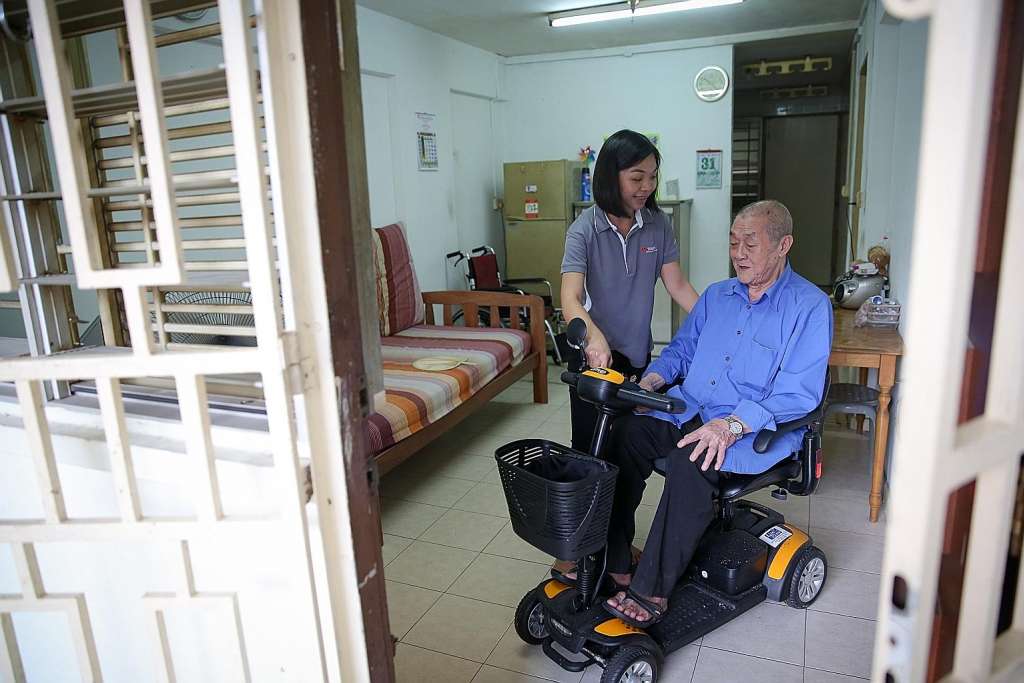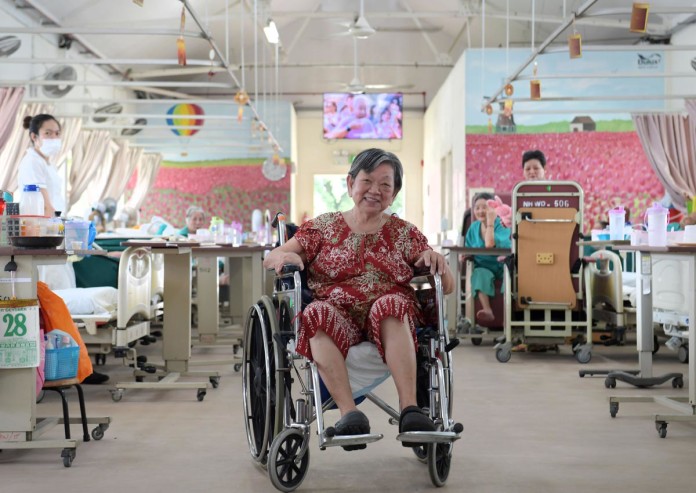A stroke in May last year did not kill Mr Goh Keng Char, but the depression that followed almost did.
Before the stroke, Mr Goh, then 77, lived alone in a one-bedroom Housing Board rental flat in Toa Payoh. His flat-mate of over 10 years had died a year earlier.
When he was discharged from Tan Tock Seng Hospital after a seven-week stay, Mr Goh, a bachelor, felt lonely and helpless, having to use a wheelchair to move around.
“I cannot walk… I felt I had nothing to live for,” says the former water tank maintenance worker.
“I took the lift to the 12th floor of the block in my wheelchair and wanted to jump down.
“A Malay neighbour saw me in a daze and stopped me. He saved my life.”
Today, Mr Goh still cannot walk and he continues to live alone at the rental flat, but he no longer thinks about taking his life. “I have many new friends in the neighbourhood, especially the hawkers,” he says. “They do not charge me.”
He relies on voluntary welfare organisation (VWO) Touch Home Care for food, medical care and housekeeping. Twice a day, seven days a week, volunteers from Touch deliver lunch and dinner to his flat. “The food is still warm when they arrive,” says Mr Goh.
A nurse visits weekly to check on his health, and staff from the VWO clean his flat. The services are free because Mr Goh is on long-term public assistance, getting $500 a month from the Government.
Last December, Touch helped Mr Goh apply for government funding to buy a motorised scooter, and sent two occupational therapists to teach him how to use it this year.
Touch Home Care director Kavin Seow says it provides these services to seniors like Mr Goh as part of a larger government drive to help the elderly grow old where they live, instead of in nursing homes. “We recognise that the elderly want to be independent and many prefer to age at home.”
Volunteers from the VWO deliver daily meals to about 400 seniors living alone. Each month, its nurses make housecalls to about 340 seniors. It also runs a daily ambulance service ferrying the elderly to hospitals for check-ups.
Touch operates in Ang Mo Kio, Jurong and Toa Payoh. It plans to expand to Bukit Batok and Yishun next year, but it is feeling the heat from the manpower crunch in the sector.
“Manpower challenges continue to be a concern for us, as it is important to recruit people with the right skills and heart for the work,” says Mr Seow.
Mr Goh appreciates the help. “I have no relatives, so she is like family to me,” he says, pointing to occupational therapist Doreen Ang, who accompanied Insight to visit him last week. Mr Goh had five siblings but they have died and their children do not visit him.
Ms Ang, who taught Mr Goh how to use the motorised scooter, downplays her role, saying: “Mobility is important for seniors socially, so I helped him get around the neighbourhood safely.”
The 24-year-old graduated with a degree in occupational therapy last year and could have easily found work in hospitals, but she opted to work at Touch. She says: “I can make a direct impact on the seniors in a community setting.”
Mr Goh is thankful for the motorised scooter, saying he is no longer confined to the flat.
When Insight asked if he would consider moving to a nursing home should his health deteriorate, he retorts: “No. I’d rather die than go to a nursing home… I have lived in Toa Payoh for more than 40 years and in this flat for more than 20. I want to die here.”
Ageing in place: More support for seniors living at home
The key thrust of Singapore’s ageing policy is based on the view that most people want to be cared for at home or in the community. That’s because they feel more comfortable in familiar settings and around people they know.
And that is why the Ministry of Health (MOH) has ramped up aged care services significantly of late. Over the past five years, centre-based daycare places rose by 67 per cent, and seniors receiving care services in their homes increased by 82 per cent, says the MOH.
The ministry intends to keep up this momentum. The number of daycare places, where older people go for rehabilitative and social activities, will jump from 3,500 last year to 6,200 in 2020. Likewise, the capacity to care for seniors in their homes is expected to rise by 45 per cent from the 6,900 available last year to 10,000 by 2020.
Daycare centres and home- based care services – such as meal delivery, medical escorts, personal and nursing care, rehabilitation and “elder-sitting” for those with dementia – allow seniors with mild or moderate disability to still be able to age well at home.
For those with more complex needs, the MOH has started piloting integrated care packages this year that bundle both home- based and centre-based care to serve needs of seniors holistically.
However, the capacity to provide daycare and home-based care services remains minuscule compared with the vast, growing ranks of people turning grey.
The number of elderly living alone increased from 6,000 in 1990 to 29,000 in 2011 and is estimated to reach 92,000 by 2030. Disability rates among the elderly are expected to rise, even as the number of family caregivers shrinks.
To cope with heavy caregiving work, Singaporeans have been accustomed to outsourcing care to foreign domestic workers.
The MOH piloted a programme last year to train domestic helpers – both in the classroom and on the job – so that they can look after seniors better. But that pool of labour is dwindling, with source countries limiting supply and maids less keen to work here.
To have enough manpower, the rest of the community will need to fill the gap, experts say – pointing to volunteers. Tsao Foundation, a non-profit group that specialises in ageing issues, has more than 120 trained volunteers who help regularly in counselling and organising activities.
“Volunteers make a critical contribution to the care of our elderly clients,” says Ms Doris Low, director of community relations at Tsao Foundation. “(Volunteering) is also one way in which we can support one another in an ageing society instead of seeing older people as ‘others’.”
Right at home in a nursing home

For the past 16 years, home for Madam Chew Eng Huay has been a chronic sick ward, and then a nursing home.
A stroke in 2000 left her unable to walk, talk or feed herself, so she went from her sister’s flat to the Ren Ci long-term care facility in Hougang. Eight years later, she was wheeled into Ren Ci nursing home in Jalan Tan Tock Seng where she continued to be bed- bound and fed through a tube.
The nursing home is made up of seven single-storey buildings. Madam Chew, 70, lives with 29 others in one of the cavernous rooms.
Her first thought when she was brought in was to go back home. She was fearful of not being able to go wherever she wanted. Today,she seems to be a different person.
It was barely lunchtime when The Sunday Times visited her two weeks ago and “Ah Huay”, as she is affectionately called, was already cooking a pot of red bean soup for dessert. She whips up a sweet treat for the residents every Thursday.
“I cook anything, red bean, green bean, chrysanthemum or barley soup,” said Madam Chew, brandishing a ladle as she stretched to stir the soup from her wheelchair. She carefully scooped up pandan leaves from the pot with her left hand, as the right side of her body is paralysed.
With intensive rehabilitation and good care, she is now able to talk, eat on her own and wheel herself around by using her left leg to propel the wheelchair forward.
“I like it here, I like everything about this place,” she said.
Madam Chew may be one of the many residents of the nursing home, but she enjoys helping the nurses run the place.
During breakfast, she helps to feed one of the residents. Then she transfers herself onto a motorised scooter to go around delivering bedsheets, eggs and bread to residents in other wards. After lunch, she sometimes plays mahjong with her close friends using her one good hand.
“I need to have things to do. It makes me happy,” said Madam Chew, who could not sit still even during this interview. Intermittently, she would check on her red bean soup or ensure that someone was feeding a certain resident.
She said she is accustomed to hard work as she used to sell coffee and bread at Lau Pa Sat. Later, she also helped her father sell ice kacang at his hawker stall in Havelock Road.
Madam Chew is single and has an older sister and an estranged younger brother. Their father left them a three-room flat in Bukit Ho Swee, which they sold.
“I don’t like to stay alone at home as I am scared. What if I die and no one finds me even after one or two weeks?” she said in Mandarin.
“Even if there are care workers who can come to my home to help, I don’t think they are able to do so every day,” she added.
She said she does not mind sacrificing personal space and privacy. One neighbouring resident, she pointed out, scolds her each time she passes by and another rambles on about winning the lottery.
She has injected her personality into the impersonal space by pasting Hello Kitty and other cartoon stickers on the cupboard next to her bed. And she wears red and black floral blouses and trousers instead of the green pyjamas that everyone else wears. A nurse from Myanmar, who treats her “like mum”, bought the outfits for her.
Madam Chew, with her cheerful disposition and active lifestyle, may be an exception in her ward. The other residents seem listless and stay in their beds or chairs.
“I used to work so hard in the past and didn’t have time to help others. So this is my form of volunteer work now,” said Madam Chew.
Nursing homes: Mega, multi-storey facilitiesbeing built in rush to increase number of beds
For the past few months, motorists driving along Ang Mo Kio Avenue 1 near Bishan-Ang Mo Kio Park would have seen the new Ren Ci Nursing Home taking shape. When the 11-storey building is completed around next June, it will house up to 470 residents.
Meanwhile, in Chinatown, beds and blood-pressure measuring machines have replaced desk and dusters at a former primary school. The Pearl’s Hill Care Home, which officially opened in September, is Singapore’s first government-run nursing home.
From constructing new buildings to refurbishing old ones, Singapore is expanding the number of nursing home beds in a hurry.
Singapore has around 12,000 nursing home beds, up from 9,200 in 2010. Another 5,000 will be added by 2020, an increase of 85 per cent over 10 years.
By financial year 2015, the Government was spending $360 million on nursing homes, most of it for patient subsidies, manpower costs and construction. This is more than three times what it spent in financial year 2011.
The pressure to ramp up capacity rapidly has led to two heavyweights – the Government and the National Trades Union Congress – jumping into the segment to run their own nursing homes.
By next year, Kwong Wai Shiu Hospital will have Singapore’s largest nursing home in a new 12-storey hub that will see a doubling in its number of beds to 622. An 11-storey, 342-bed home in Chai Chee run by NTUC Health Co-operative and a 290-bed home in Hougang run by Thye Hua Kwan Moral Society are expected to be ready this year.
Such massive projects have led observers to ask whether Singapore is churning out cookie-cutter nursing homes with soulless dormitory-style wards.
Pearl’s Hill Care Home, for example, has four large halls for 32 residents each. The Ministry of Health, which runs the home, declined Insight’s request for a visit.
Dr Phillip Yap, a geriatrician who has published research papers on nursing homes here, says: “Dormitory living and regimented routines are the norm. Residents have little control over their daily routines and there is minimal privacy.”
Meanwhile, the MOH has tried to improve the quality of care in nursing homes by introducing the new Enhanced Nursing Home Standards (ENHS) as part of licensing requirements. Nursing homes were given one year – ended April this year – to comply. Ms Loh Shu Ching, chief executive of Ren Ci Hospital, notes: “The ENHS will definitely provide safer care for the nursing homes but it is going to make things more difficult for those of us trying to turn the nursing home into a home and not a hospital.”
There’s Hope for dementia patients

It is only 11.20am but a lunch queue has already formed at an in-house cafe along Upper Changi Road North. In the line are old folk, leaning on walking sticks, waiting patiently for their turn.
They tell the servers the portions they are feeling up to that day. They then carry their plates to nearby tables and join whoever they want to dine with. When they are done, they empty the food waste in a bin and leave the plates and utensils in separate tubs.
These elderly folk, most of whom are in their 80s and 90s, have dementia. But the people who run the assisted living facility where they live believe that getting them to do little things and make decisions for themselves will empower them.
“This is not the kind of place where they just sit there and wait to be served. Giving them a say in simple things matters, because it keeps them engaged in life,” says Ms Josephine Khai, senior staff nurse of Peacehaven nursing home.
The home is run by a charity, the Salvation Army, but these relatively independent seniors are housed next door in a separate five-storey building. Called Hope, the area where they live is modelled after an HDB block. There are about 60 senior citizens with mild to moderate dementia who live in single or four-bed rooms.
In the morning, they wake up whenever they want. They are expected to change out of their pyjamas. In contrast, at some nursing homes, it is common for residents to wear the same outfit all day.
“These are environmental cues and will put them in the frame of mind to get their day going,” says Ms Khai.
When Insight visited two weeks ago, some were in the cafe, piecing together jigsaw puzzles. Others watched television or read the newspapers. Another group went into a room to belt out the classics tunes of Taiwanese pop singer Teresa Teng.
They do not need to follow a regimented timetable, but there is a list of specific activities available each day. If they prefer to rest in their rooms, they may do so.
Before going into their rooms to deliver fresh laundry or remind them to shower, nurses make it a point to knock on their doors first to ask for permission to enter, so as not to intrude on their personal space and privacy.
Though some of the seniors are prone to wander, they are not kept within their “HDB block”. Every Wednesday, they go to a factory across the road for a morning snack at the canteen. Every Friday, they walk to the Japanese school next door to say hello to the children.
Hope was started in 2006 after the charity saw a need to provide care that helps relatively independent seniors with dementia. Since then, about 100 have lived there. They pay the same rates as the nursing home residents next door, between $2,800 and $4,500 before subsidies of up to 75 per cent.
Peacehaven is not alone in having the concept of assisted living facilities.
Over at Lentor Residence, two in three of its 208 beds are in single or twin-occupancy rooms with attached toilets. The floors of the common areas are carpeted and there is free Wi-Fi.
The home’s chief executive Jonathan Koh says it was set up as a retirement village in 1997. “But there was no demand, so we ran it like a nursing home, taking in subsidised residents.”
A room does not come cheap – $240 a day, or more than $7,000 a month. The price includes meals, laundry and housekeeping services.
Ms Khai says that living in a home-like environment has helped residents enhance their quality of life. Assessments show an average of a 30 per cent increase in the sense of well-being after living there.
Assisted living facilities: Govt integrating services for seniors within neighbourhoods
The elderly in Singapore have hardly any other housing options besides nursing homes if they grow frail and need someone to take care of them.
In countries such as the United States, Australia and Finland, about 5 per cent of the elderly population live in some form of residential aged care facility. Going by this estimate, about 50,000 seniors in Singapore will need such facilities by 2030. But there are only about 12,000 nursing home beds now.
Assisted living facilities provide a more home-like environment, such as private rooms, for more independent seniors who need help with personal care.
Standalone assisted living options are virtually non-existent in Singapore. The small pockets that exist are mostly nursing homes that have set aside separate spaces for assisted living.
While Singapore has 14 senior group homes, they do not count as assisted living facilities as residents do not get help with daily activities. Senior group homes are clusters of rental flats meant to let elderly folk with little or no family support live together with one another in an environment which they are familiar with.
The Ministry of Health (MOH) says assisted living is a service worth studying. “Many citizens own their own homes within public housing estates. Therefore, assisted living takes the form of injecting a range of services within such estates in Singapore,” says its spokesman.
The Government seeks to integrate services within neighbourhoods in two ways. First, it has been retrofitting existing mature estates to create conducive environments for seniors. In Marine Terrace, Jalan Batu, Nee Soon Central and Beach Road, for instance, there is a range of services and facilities – including an active ageing centre, community kitchen, senior activity centre and day rehabilitation centre – within the same area.
Second, it is including senior services in new public housing developments. New Housing Board projects will have “Active Ageing Hubs”, or larger spaces where various eldercare services such as daycare centres and rehabilitation are located.
The MOH is also encouraging private operators and voluntary welfare organisations to provide assisted living services, such as housekeeping and grocery-shopping, for seniors who require assistance. A senior activity centre at a new studio apartment development in Marsiling has been offering residents nearby health and dental check-ups, and taking grocery orders.
Nursing homes like Peacehaven have also taken the initiative to experiment and come up with assisted living spaces for more mobile and able seniors, who still get the usual nursing home subsidies of up to 75 per cent.
jantai@sph.com.sg
tohyc@sph.com.sg
Read also: No bed at the nursing home, so couple forced to stay apart
Growing old: Should you be worried?
10,000 more healthcare workers needed in next 3 years

This article was first published on Nov 06, 2016.
Get a copy of The Straits Times or go to straitstimes.com for more stories.







